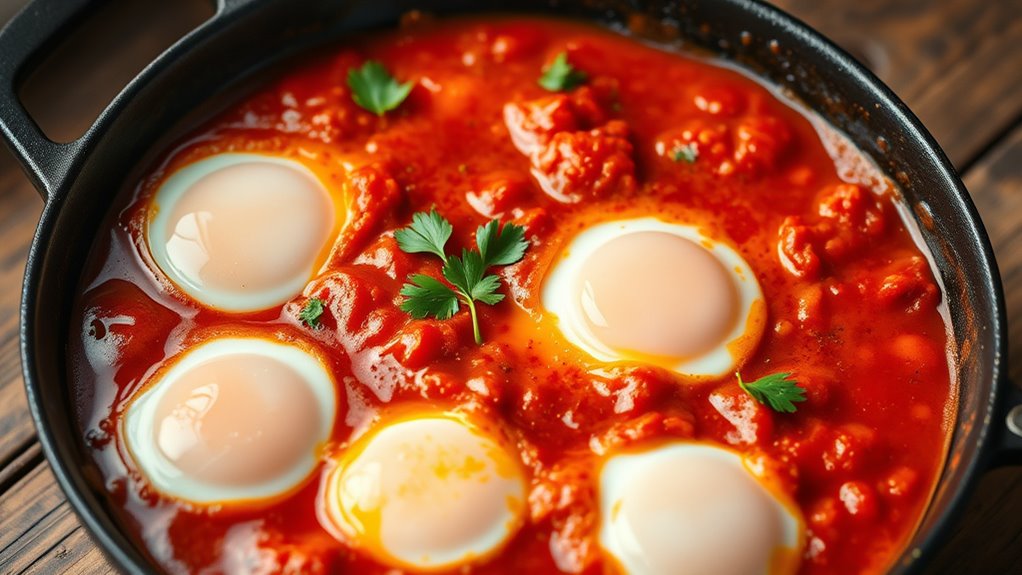Shakshuka originated in North Africa and the Middle East, blending Ottoman, Berber, and regional influences. To cook it perfectly, start with a rich tomato sauce seasoned with spices like cumin, paprika, and cayenne. Simmer the sauce until thick, then gently crack eggs into indentations, covering the pan to poach until whites set and yolks reach your preferred doneness. If you want to master this dish, you’ll find key techniques and tips by exploring further.
Key Takeaways
- Shakshuka originates from North Africa and the Middle East, blending Ottoman and Berber culinary influences.
- Use high-quality, ripe tomatoes and proper spices like cumin and paprika for authentic flavor.
- Sauté onions and garlic, then simmer tomatoes until thickened before adding eggs.
- Create indentations in the sauce, crack eggs carefully, and cook on low heat until whites are set.
- Serve directly from the skillet with bread, garnished with herbs like cilantro or parsley for best results.
The Historical Roots of Shakshuka in North Africa and the Middle East

Shakshuka has deep roots in North Africa and the Middle East, where it has been a staple for centuries. You’ll find it deeply woven into local cultures, often served for breakfast or any hearty meal. Its origins trace back to Ottoman and Berber influences, blending spices and ingredients from various regions. Historically, it was a humble dish made with simple, locally available ingredients like tomatoes, peppers, and eggs. Over the centuries, it became a symbol of communal eating, bringing people together around a shared plate. As you explore its history, you’ll notice how it reflects the diverse culinary traditions of North Africa and the Middle East, showcasing a fusion of flavors that have stood the test of time. Additionally, it’s cultural significance continues to thrive in contemporary cuisine across these regions. The traditional preparation methods have also been preserved, maintaining the authenticity and connection to its cultural roots. Modern techniques, including authentic cooking methods, help keep this culinary tradition alive for new generations to enjoy. Recognizing the culinary evolution of shakshuka highlights how it has adapted while still honoring its origins. A variety of regional variations further illustrates its enduring popularity and cultural importance across different communities.
Variations of Shakshuka Across Different Regions
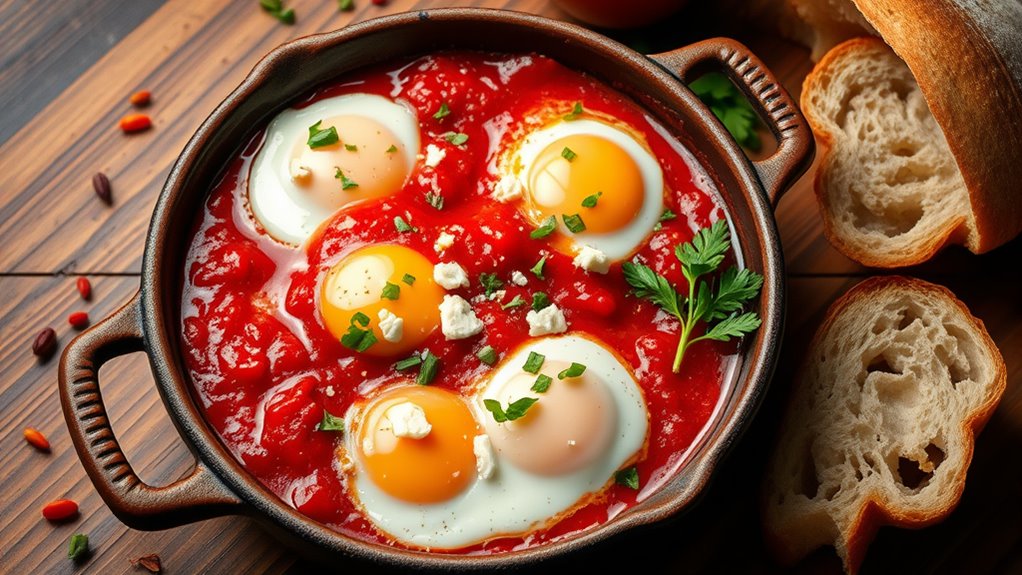
Across different regions, shakshuka takes on unique flavors and ingredients that reflect local tastes and available produce. In North Africa and the Middle East, you’ll find a spicy, tomato-based sauce often seasoned with cumin, paprika, and harissa. As you move east toward Israel and the Levant, toppings like feta cheese, fresh herbs, and sometimes chickpeas add variety. In parts of North Africa, eggs are cooked directly in spicy pepper sauces or with vegetables like zucchini and eggplant. You might also encounter regional twists such as:
Shakshuka varies regionally with spices, herbs, and local ingredients reflecting diverse culinary traditions.
- Adding local herbs like za’atar or cilantro
- Incorporating regional vegetables like bell peppers or spinach
- Using different types of cheeses or meats for richer flavor
- The regional variations of shakshuka demonstrate how cultural influences shape the dish’s ingredients and preparation methods. These variations also showcase the regional culinary diversity that makes shakshuka a versatile and beloved dish across different countries. The use of specialized cookware in some regions influences the cooking technique and presentation of the dish. Additionally, the traditional cooking techniques employed in various areas contribute to the distinct textures and flavors that characterize each version, highlighting the importance of cooking methods in defining regional tastes.
Essential Ingredients for Authentic Shakshuka
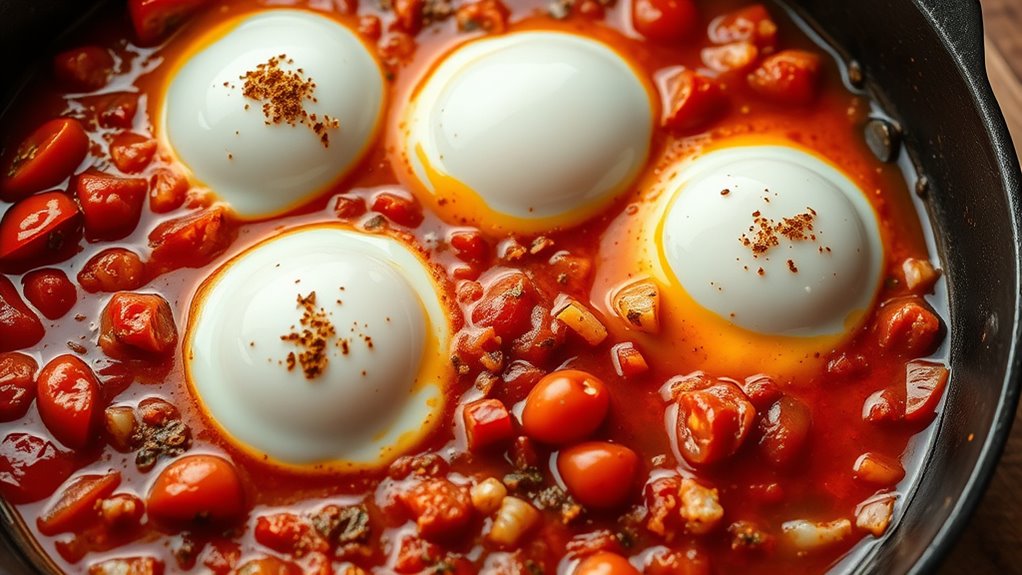
To create an authentic shakshuka, you need a handful of key ingredients that form its flavorful foundation. First, ripe tomatoes are essential; use fresh or high-quality canned tomatoes for a rich, vibrant base. You’ll also need eggs, which are gently cooked in the sauce to create that signature texture. A good drizzle of olive oil adds depth and authenticity. Onions and garlic are vital for building flavor; sauté them until fragrant. Salt and pepper season the dish, enhancing the natural tastes. Finally, a pinch of sugar balances acidity from the tomatoes. These ingredients come together to create the classic shakshuka experience, setting the stage for the spices and seasonings that give it its unique character.
The Role of Spices and Seasonings in Shakshuka
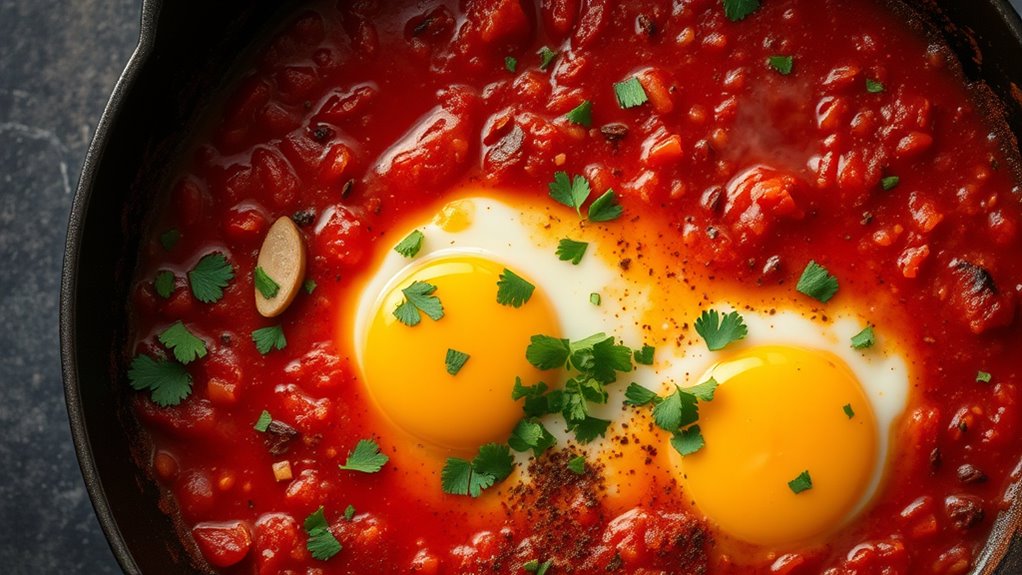
Spices and seasonings are what truly define the bold, complex flavor profile of shakshuka. They elevate simple ingredients into a vibrant, aromatic dish that wakes up your palate. The key spices include cumin, paprika, and cayenne, which add warmth, depth, and a touch of heat. Seasonings like salt and pepper enhance each layer, balancing the acidity of the tomatoes. Fresh herbs, such as parsley or cilantro, brighten the dish and add freshness. To perfect your shakshuka, consider these points:
- Use ground spices for a rich, even distribution of flavor.
- Adjust heat levels with cayenne or chili flakes according to your taste.
- Finish with fresh herbs for a burst of color and aroma.
These elements make your shakshuka uniquely flavorful and satisfying.
Step-by-Step Guide to Preparing the Perfect Tomato Sauce
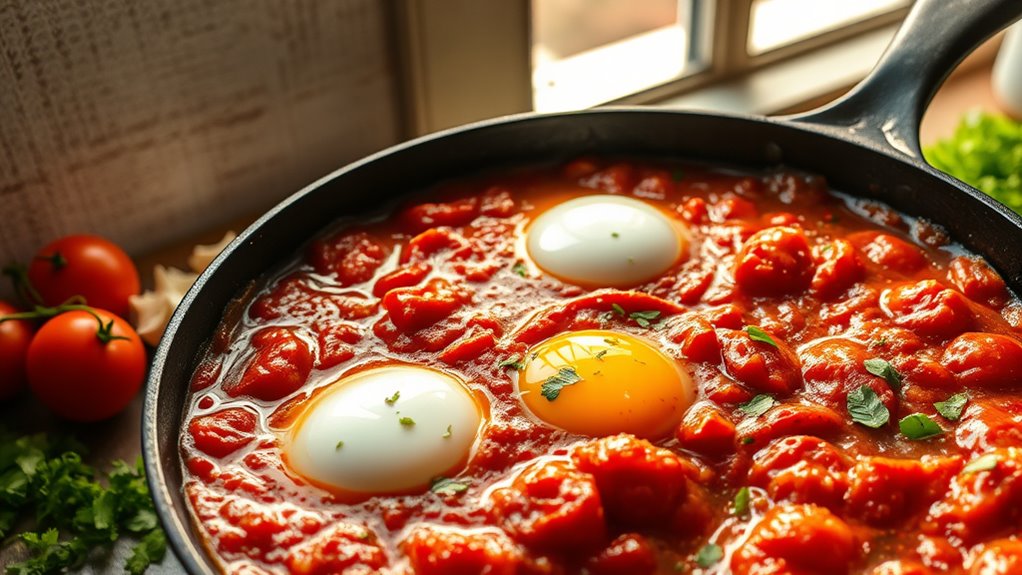
To make a flavorful tomato sauce, start by choosing ripe, quality tomatoes for the best taste. Then, focus on perfecting your spice blend to enhance the natural flavors. Additionally, incorporating fresh herbs can elevate the sauce’s aroma and complexity. Using the right cooking techniques can also ensure the sauce develops a rich, well-rounded flavor. For optimal results, understanding color accuracy in your ingredients can help select the freshest produce, and simmering the sauce until it thickens and develops depth, ensuring it’s just right for your shakshuka.
Selecting Quality Tomatoes
Choosing the right tomatoes is essential for achieving a rich, flavorful sauce. Fresh, ripe tomatoes provide natural sweetness and depth that form the foundation of your shakshuka. Look for tomatoes that are firm but slightly soft to the touch, with vibrant color and minimal blemishes.
To select quality tomatoes:
- Opt for heirloom or vine-ripened varieties for superior flavor.
- Avoid tomatoes with wrinkles, cracks, or dull skin.
- Choose those with a balanced acidity that complements your sauce.
Your goal is to find tomatoes that are juicy and fragrant, ensuring a robust, well-rounded base. Skipping subpar produce results in a dull, watery sauce that won’t deliver the authentic taste you seek.
Perfecting the Spice Blend
Once you’ve selected ripe, flavorful tomatoes, the next step is to craft a balanced spice blend that will elevate your sauce. Start with cumin and paprika for warmth and depth, then add a pinch of cayenne or chili flakes for heat. Freshly ground black pepper and a touch of salt enhance the overall flavor. Consider including a dash of smoked paprika for smoky richness or a bit of cinnamon for subtle sweetness, if desired. Taste as you go, adjusting spices to suit your preference. The goal is to create a harmonious blend that complements the acidity of the tomatoes without overpowering them. Keep your spice measurements moderate—you want the flavors to enhance, not dominate, the natural tomato essence.
Achieving Optimal Simmering
Achieving the perfect simmer is essential for developing rich, flavorful tomato sauce. When you keep the heat just right, the sauce thickens evenly and flavors meld beautifully. To do this, monitor the temperature closely and adjust the burner as needed. Use a gentle, steady simmer rather than a vigorous boil to prevent burning or uneven cooking. Stir occasionally to prevent sticking and ensure even heat distribution. Keep the lid partly on to trap moisture without overdoing it. Remember these tips:
- Maintain a low, steady heat throughout the process
- Stir regularly to prevent burning or sticking
- Keep the lid slightly ajar for controlled moisture release
Mastering these steps will help you achieve a vibrant, well-balanced tomato sauce perfect for shakshuka or any dish requiring a rich base.
Techniques for Poaching Eggs in Spicy Tomato Mixture

To successfully poach eggs in a spicy tomato mixture, start by simmering the sauce until it’s thick and flavorful. Make small indentations in the sauce using a spoon, creating space for each egg. Crack each egg carefully into these gaps, avoiding breaking the yolks. Cover the skillet and cook on low heat. This gentle simmer allows the eggs to poach evenly without overcooking. Keep an eye on the yolks; they should remain runny, which enhances the dish’s richness. If you prefer firmer yolks, cook a bit longer. Use a spoon to baste the whites gently with the sauce, ensuring even cooking. Once the whites are set and the yolks reach your preferred consistency, remove the skillet from heat and serve immediately. Incorporating proper spinal alignment during cooking can help prevent strain and discomfort.
Tips for Achieving the Ideal Consistency and Flavor Balance

To get the perfect shakshuka, focus on adjusting the tomato sauce to your preferred thickness—whether you like it rich or more runny. Balance the spice level by tasting as you cook, adding more chili or sweetness as needed. Keep an eye on the eggs, timing their cooking just right so they set without overcooking. For an authentic touch, consider incorporating best anime movies or animated films that touch hearts to inspire your culinary creativity.
Tomato Sauce Texture
Getting the tomato sauce just right is key to a perfect shakshuka, and that starts with managing its texture. You want it thick enough to hold the eggs but still saucy enough to soak into crusty bread. To achieve this, simmer the sauce gently to allow excess moisture to evaporate without burning. Stir occasionally to prevent sticking and promote even thickening. Additionally, using modern heat pump systems with noise reduction technology can help maintain a quiet kitchen environment while you cook. Consider these tips: – Use crushed or diced tomatoes for a smoother, more cohesive sauce. – Adjust simmering time based on your desired thickness—longer for less liquid. – Incorporate a pinch of sugar or a splash of water if the sauce becomes too thick or acidic. Balancing these elements ensures your sauce complements the eggs perfectly. Incorporating proper heat control is essential for preventing burning and achieving the ideal consistency.
Spice Level Balance
Achieving the right spice level in your shakshuka enhances both flavor and balance, ensuring the dish isn’t overwhelmed by heat or lacking in depth. Start with small amounts of chili or hot paprika, tasting as you go. Remember, spices develop their heat gradually, so add gradually and adjust accordingly. Incorporate milder spices like cumin or coriander to create a well-rounded flavor profile that complements the heat. If you find the dish too spicy, balance it with a touch of sweetness from honey or sugar, or add a splash of acidity with lemon juice or vinegar. Keep in mind that the flavors meld and mellow as the dish simmers, so aim for a slightly milder spice level initially. This approach guarantees a flavorful, balanced shakshuka every time. Monitoring AI behavior is essential to prevent unintended bias or safety issues in your cooking process. Additionally, understanding spice level balance can help you customize the dish to suit varying taste preferences and dietary needs. For example, knowing how to adjust spice levels can be complemented by proper flavor balancing techniques, ensuring the final dish remains harmonious and enjoyable for all.
Egg Cooking Timing
Timing is essential when cooking eggs in shakshuka, as the right moment guarantees they reach your desired consistency and flavor balance. To achieve perfect eggs, keep a close eye on them as they cook. Generally, if you prefer runny yolks, cook for about 4-5 minutes until whites are set but yolks remain liquid. For a firmer texture, aim for 6-8 minutes. Remember these tips: – Cover the skillet to speed up cooking and ensure even heat. – Check the whites frequently to avoid overcooking. – Remove from heat just before reaching your perfect doneness, as residual heat will finish the process. AI discoveries in healthcare have shown that precise timing can significantly impact the outcome. Adjust timing based on your preference, but always monitor closely for ideal results. Incorporating proper heat management can further enhance your cooking precision and consistency.
Serving Suggestions and Traditional Accompaniments
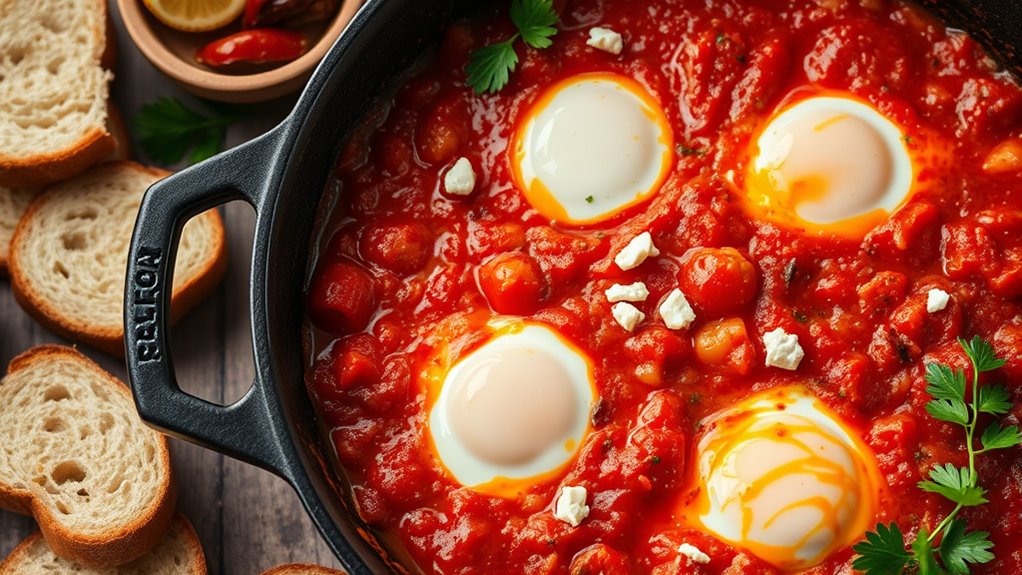
Shakshuka is traditionally served directly from the skillet, making for an authentic and communal dining experience. You’ll often find it paired with crusty bread like baguette or pita, perfect for scooping up the rich tomato sauce and runny eggs. Fresh herbs such as cilantro or parsley add brightness and flavor, sprinkled on top just before serving. Many enjoy it with a side of pickles or olives, which provide a tangy contrast. For added richness, serve with feta cheese or labneh. Some also like a splash of hot sauce or harissa for extra spice. Keep your presentation simple, emphasizing the dish’s rustic charm, and encourage sharing to enhance the social aspect of this beloved meal. Proper display techniques can also elevate the visual appeal, making the dish even more inviting.
Common Mistakes and How to Avoid Them

Avoid overcrowding your pan, as it prevents the eggs from cooking evenly. Use fresh, high-quality eggs for the best flavor and texture. Keep a close eye on the heat to prevent burning or undercooking your shakshuka. Additionally, understanding the inspirational quotes about fatherhood can remind you to approach cooking with patience and care, much like nurturing a meaningful relationship. Proper pan size is essential to ensure even cooking and prevent overcrowding. Selecting the right materials needed for candle making can also influence the consistency and success of your dish by ensuring uniform heat distribution.
Overcrowding the Pan
One common mistake when making shakshuka is overcrowding the pan, which can cause the ingredients to steam rather than sear properly. When the pan is too full, the heat doesn’t distribute evenly, making it hard to develop the rich flavors you want. To avoid this, cook in batches if needed, and give each ingredient room to breathe. This ensures they brown nicely and release their juices effectively.
- Use a wide, shallow pan to maximize space
- Add ingredients gradually, not all at once
- Don’t overfill the pan beyond its capacity
Using Low-Quality Eggs
Using high-quality eggs makes a noticeable difference in the final dish. Low-quality eggs can lead to bland flavor, watery whites, and uneven cooking. When eggs are fresh and well-produced, they hold their shape better, and their vibrant yolk adds richness to your shakshuka. Avoid eggs that look dull, have thin shells, or emit a sulfurous smell. Choosing fresh, high-quality eggs ensures a more satisfying experience and elevates your dish’s overall flavor.
| Quality Egg | Freshness | Flavor | Texture | Appearance |
|---|---|---|---|---|
| Bright yolk | Firm whites | Rich | Firm & cohesive | Vibrant color |
| Thin shell | Slight smell | Mild | Watery whites | Dull color |
| Dull yolk | Old | Bland | Runny whites | Pale color |
| Cracked | Stale | Off-flavor | Mushy whites | Discolored |
| Uneven whites | Spoiled | Unpleasant | Watery | Mottled shell |
Not Controlling Heat
Ever wonder why your shakshuka ends up overcooked or burned? It’s usually because you’re not regulating the heat properly. High heat can scorch the tomatoes and eggs, ruining the dish. To avoid this, keep your heat at a gentle simmer rather than a rolling boil.
Pay attention to these common mistakes:
- Turning up the heat too high, causing burning or uneven cooking
- Leaving the pan unattended, leading to overcooking or sticking
- Moving the pan suddenly from stove to table, which can cause temperature spikes
To get perfect shakshuka, stay attentive, adjust the heat as needed, and keep the temperature steady. This ensures the eggs cook evenly and the sauce stays flavorful without burning. Proper heat control is key to a delicious, beautifully cooked shakshuka.
Modern Twists and Creative Variations of Shakshuka

Have you ever wondered how chefs put fresh spins on traditional shakshuka to excite your taste buds? Modern twists involve adding unexpected ingredients like feta, goat cheese, or even spicy chorizo, creating rich, layered flavors. Some chefs experiment with different vegetables, such as sweet potatoes, zucchini, or eggplant, to add texture and sweetness. Creative variations also include using different sauces—harissa, roasted red pepper, or even curry for a global twist. You can serve shakshuka with various breads, from pita to sourdough, or even over grains like quinoa or couscous for a hearty twist. These innovations keep the dish lively and adaptable, allowing you to tailor it to your preferences while honoring its vibrant roots.
Frequently Asked Questions
What Are the Best Tools for Making Shakshuka at Home?
To make shakshuka at home, you’ll need a few key tools. A good, deep skillet or cast-iron pan is essential for even cooking. A wooden spoon helps stir the sauce without scratching your pan. A ladle makes serving easy, and a lid can help simmer the eggs perfectly. Finally, having a sharp knife and cutting board ensures you prep ingredients efficiently. These tools make the process smooth and enjoyable.
How Can I Make Shakshuka Suitable for Vegan Diets?
To make shakshuka vegan, you can swap out eggs for plant-based alternatives like tofu or chickpeas. Use flavorful vegetables, tomatoes, and spices to create a rich sauce, and consider adding nutritional yeast for a cheesy flavor. Keep the cooking method simple—sauté your vegetables, simmer the sauce, then add your vegan protein. Serve with crusty bread or pita for a satisfying, plant-based meal your friends will love.
Is There a Traditional Time of Day to Serve Shakshuka?
You might wonder when to serve shakshuka, and there’s no strict rule. It’s versatile enough for breakfast, brunch, lunch, or dinner. Many enjoy it in the morning with bread and coffee, but it also makes a hearty lunch or dinner option. You can serve it anytime you crave warm, flavorful comfort. Ultimately, you choose the time that fits your mood and schedule, making shakshuka a flexible, delicious meal.
Can Shakshuka Be Prepared in Advance and Reheated?
You can definitely prepare shakshuka in advance and reheat it later. Just cook the dish as usual, then let it cool completely before storing it in an airtight container in the refrigerator. When you’re ready to eat, gently reheat it on the stove or microwave until it’s hot. Keep in mind, the eggs may become firmer, but overall, reheating preserves the flavors and makes for a quick, satisfying meal.
What Wine Pairs Well With Shakshuka?
Did you know that pairing wine with flavorful dishes enhances the experience by 60%? For shakshuka, go for a crisp white like Sauvignon Blanc or a light red such as Pinot Noir. These wines balance the spicy, tangy tomato base without overpowering it. You’ll enjoy each bite more fully when your wine complements the bold flavors, making your meal even more satisfying and memorable.
Conclusion
Now that you know the secrets to making authentic shakshuka, you’re practically a culinary magician! Mastering its rich flavors and perfect consistency will turn any meal into an unforgettable feast. Don’t be surprised if your friends start calling you the “Shakshuka King” or “Queen” — your skills are truly world-class. So go ahead, get cooking, and let this vibrant dish transform your breakfast or dinner into a flavor-packed adventure!
